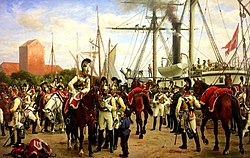| Royal Horse Guards | |
|---|---|
| Livgarden til Hest | |
 Royal Horse Guards at Korsør on the way to the front line in Schsleswig during the First Schleswig War in 1848. Painting by Otto Bache from 1888. | |
| Active | January 1661−31 May 1866 (205 years, 4 months) |
| Country | |
| Branch | |
| Type | Cavalry |
| Role | Guard and escort duty |
| Size | 675 men at its height in 1714 |
| Part of | Royal Life Guards |
| Garrison/HQ | Hestegardekassernen [1] |
| Engagements |
|
| Commanders | |
| Notable commanders | Friedrich von Arensdorff [2] |
The Royal Horse Guards (Danish: Livgarden til Hest) was a Cuirassier regiment in the Royal Danish Army which was founded on orders from King Frederick III in January 1661 and discontinued on 31 May 1866. It served both as Royal Guards and as a front line cavalry unit. [3]